扩展功能
文章信息
- 侯明才, 邢凤存, 徐胜林, 林良彪, 刘欣春, 熊富浩, 黄虎
- HOU MingCai, XING FengCun, XU ShengLin, LIN LiangBiao, LIU XinChun, XIONG FuHao, HUANG Hu
- 上扬子E-C转换期古地理格局及其地球动力学机制探讨
- Paleogeographic Patterns of E-C Transition Period in the Upper Yangtze and the Geodynamic Mechanism
- 沉积学报, 2017, 35(5): 902-917
- ACTA SEDIMENTOLOGICA SINCA, 2017, 35(5): 902-917
- 10.14027/j.cnki.cjxb.2017.05.004
-
文章历史
- 收稿日期:2017-09-13
- 收修改稿日期: 2017-09-23
2. 成都理工大学沉积地质研究院, 成都 610059;
3. 成都理工大学地球科学学院, 成都 610059
2. Institute of Sedimentary Geology, Chengdu University of Technology, Chengdu 610059, China;
3. College of Earth Sciences, Chengdu University of Technology, Chengdu 610059, China
Ediacaran-earliest Cambrian(E-C)转换时期,全球的生物、海洋和地球化学环境同时发生了显著的变化,最显著的是Ediacaran动物群在新元古代末期的消失,随之而来的是早寒武世骨骼动物的大爆发[1-9]。国内外的科学家对中下扬子地区E-C转换时期的古地理、古海洋环境开展了深入的研究工作[10-16],却鲜有关于上扬子地区E-C转换时期古地理格局的报道。1994年版和2009年版的中国南方古地理图显示上扬子地区震旦、早寒武世皆为稳定的碳酸盐岩台地,以碳酸盐岩沉积为主,而新近的四川盆地及周缘油气地质调查和中石油、中石化所实施的盆内钻井及地震资料显示,灯影组三段和早寒武世,上扬子台地有明显的台—棚分异格局。那么这种台—棚分异的格局究竟如何,其动力学机制什么呢?本文从E-C转换时期几个关键节点的古地理格局和Rodinia大陆裂解事件回答了上述两个问题。
1 上扬子地区晚震旦世灯影组灯三—灯四段沉积期沉积古地理格局上扬子地区震旦系地层主要由下震旦统陡山沱组(或观音崖组)和上震旦统灯影组构成(图 1a)。陡山沱组主要分布在上扬子地区的东部、中部和南部及东南部等地区,主要为一套台地—陆棚相沉积背景的白云岩类、黑色页岩及含磷质岩类等组成[17],在湖北宜昌—神农架地区;陡山沱组普遍与南华系南沱组冰碛岩平行不整合接触(图 1b)。观音崖组主要发育在上扬子的西南部、西部、北部等地区,以一套滨岸相的石英砂岩为主(图 1a,c);观音崖组与下伏峨眉山花岗岩(如峨眉山地区)、列古六组(如川西南)、铁船山组(如川北)等呈不整合接触。上扬子地区上震旦统主要由灯影组构成,主要由局限台地相的结晶白云岩、藻云岩、葡萄状白云岩和鲕粒白云岩等岩性构成(图 1a),可见砂岩、页岩和砂质砾岩等沉积,上部普遍发育硅质条带,灯影组自下而上可划分出灯一、灯二、灯三和灯四等4个岩性段(图 1a)。川中、川北和川西地区,灯一段主要由灰色、浅灰色的葡萄状白云岩、结晶白云岩、藻屑或核形石白云岩等构成,灯二段主要为灰色、浅灰色粉晶—细晶白云岩,灯三段主要为一套深灰色粉晶云岩、页岩、含砾砂岩(图 1d)和粉砂岩、细砂岩等岩性构成,灯四段主要为灰色、浅灰色粉晶白云岩、藻云岩(含叠层石)夹浅灰色、灰色和深水色硅质条带,向川南和川东南地区葡萄状白云岩可能在灯影组二段也出现,而灯影组三段碎屑岩可横向过渡为深灰色粉晶云岩。灯三段和灯二段在川北、川中—川西等地区可表现为平行不整合接触,其余地区灯组各段总体整合接触。上震旦统灯影组与下震旦统陡山沱组(灯影组)总体呈平行不整合接触(图 1a,e),而与观音崖组存在平行不整合接触(如峨眉山地区和川北地区等)。上震旦统灯影组与上覆下寒武统地层总体呈平行不整合接触(图 1f,g),其中川北地区可表现为下寒武统宽川铺组白云质灰岩(或者下寒武统筇竹寺组)与灯影组含硅质条带的藻云岩呈平行不整合接触(图 1a),在川西地区表现为含磷质岩的下寒武统麦地坪组与灯影组平行不整合接触,而在川南、川东北和川东等地区可表现为下寒武统牛蹄塘组或筇竹寺组与灯影组平行不整合接触(图 1f,g)。

|
| 图 1 上扬子地区及周缘震旦系典型岩性构成及地层界面线 Figure 1 Typical lithologic composition and stratigraphic interface line of Sinian in the Upper Yangtze region and its periphery |
灯影组晚期的灯三段和灯四段沉积时期,上扬子地区及周缘有非常明显的古地理分异,特别是在灯三段沉积时期,在上扬子陆块的边缘广泛发育一些深入台地内部的深水陆棚相区[18],如广元—绵阳—磨溪22井区、汉南古陆东侧的城口地区、川西南的峨边地区、川东的彭水老厂坪、黔北的毕节等地,在此相区内接受了黑色的泥岩沉积,而后成为上扬子地区下组合油气藏的主要烃源岩之一。在台地上主要接受了浅水陆棚相区的碳酸盐岩沉积,沉积厚度一般在200~650 m之间(图 2)。
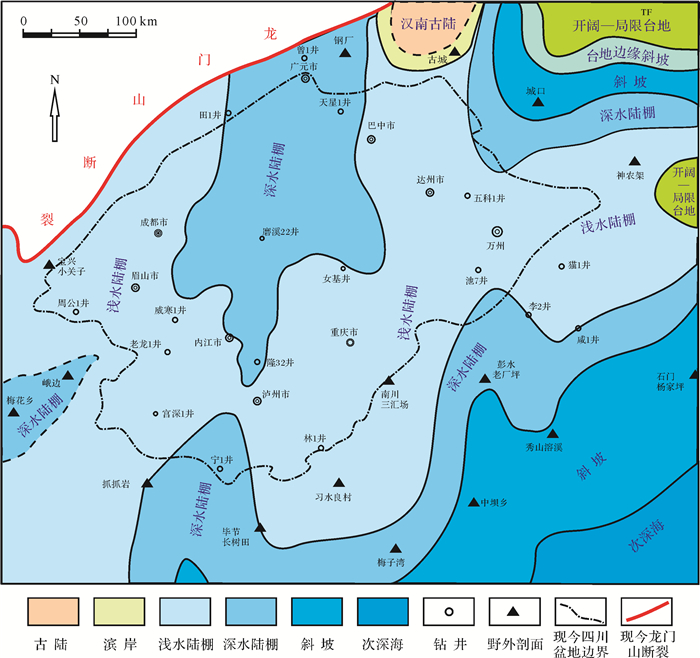
|
| 图 2 灯三段沉积时期上扬子地区及周缘古地理格局(据邢凤存等,2015,有修改) Figure 2 The paleogeographic pattern of the upper Yangtze region and its periphery during the deposition of the third segment of the Dengying Formation(modified from Xing et al., 2015) |
灯四段沉积期后,由于受到桐湾运动末期的抬升剥蚀,上扬子很多地区沉积记录未被保留。根据区域上露头、钻井和地震等资料显示的情况,认为灯四段沉积时期,整体处于一个海平面下降过程中的碳酸盐岩台地和台内礁滩的形成过程,潮坪相白云岩叠置在陆棚相之上,为一套灰白色、浅灰色中层、厚层—块状粉晶白云岩,局部夹硅质团块与条带。台内零星发育一些以一些微生物成因的丘滩沉积(图 3)。先前的深水陆棚相区被填平补齐。这些台地相藻白云岩及晶粒白云岩、颗粒白云岩、针孔白云岩,以及晚震旦世末期地壳抬升后,经地表水淋滤形成的古风化壳成为以威远气田为代表的震旦系气藏的主力储集岩。
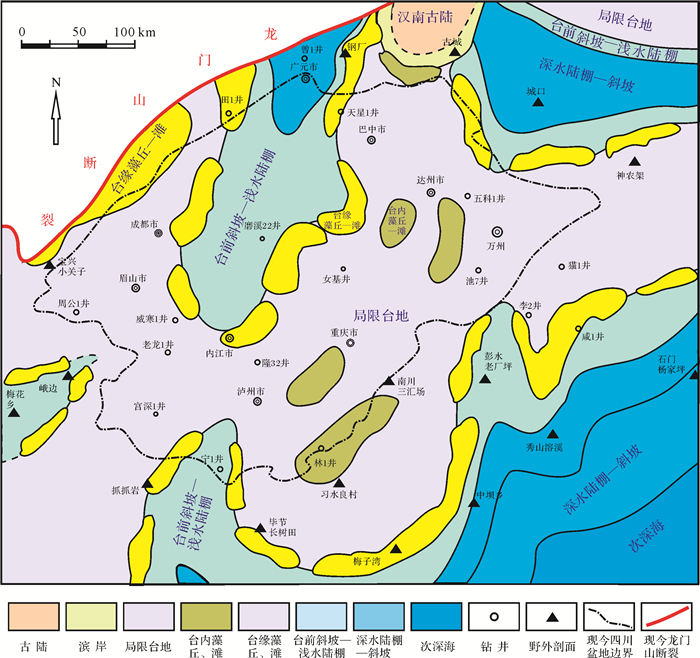
|
| 图 3 灯影组四段沉积时期上扬子及周缘古地理格局 Figure 3 The paleogeographic pattern of the upper Yangtze region and its periphery during the deposition of the fourth segment of the Dengying Formation |
寒武系地层目前为四分,早期三分的下寒武统主要对应纽芬兰统和第二统。寒武系纽芬兰统在我国统称为梅树村阶第二统包括筇竹寺、沧浪铺、龙王庙阶、南皋阶、都匀阶,不同相带部位具有一定的分阶差异性[17]。前人研究认为上扬子主体区早寒武世主要为滨岸相碎屑岩—缓坡相或者陆棚相沉积[19-20]。现今残余地层厚度显示(图 4),上扬子地区下寒武统黑色页岩发育,并伴有白云岩、硅质岩、含磷质岩、泥岩、粉砂岩、砂岩等。
基于上扬子及周缘地区早寒武世露头剖面、钻井岩芯、地震等资料所揭示的沉积相信息,综合编制了“麦地坪+筇竹寺+沧浪铺”沉积时期的古地理图(图 5),其结果显示早寒武世上扬子及周缘地区的古地理格局与灯三段沉积时期的古地理格局有着明显的相似性和对应性,特别是扬子陆块周缘的深水陆棚相区的展布基本继承了灯三段沉积时期的格局,如川北的广元—绵阳—磨溪陆棚相区、川东北的城口—万州陆棚相区、川南的内江—毕节陆棚相区、川东南的彭水老厂坪—中坝陆棚相区等,只是规模更大,水体更深,沉积的黑色泥岩厚度更大,其中的广元—绵阳—大磨溪陆棚,长约200 km,最宽处大于100 km,最窄处30 km,面积约5.4×104 km2[21-22]。这些陆棚相区的黑色泥岩也成为下古生界油气藏的主力烃源岩和页岩气勘探的主力区块。台地上则以碳酸盐岩沉积为主。
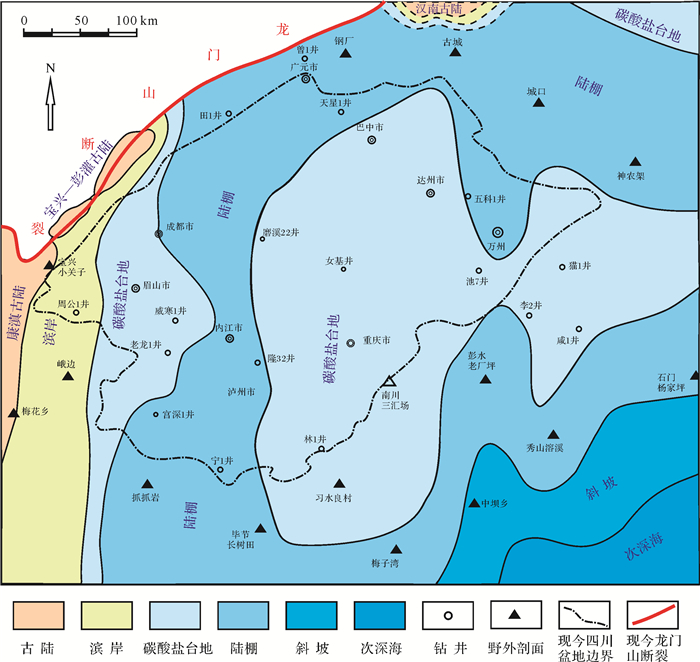
|
| 图 5 上扬子及周缘地区早寒武世(本图重点展示纽芬兰世—第二世早期)古地理格局 Figure 5 The paleogeographic pattern of the upper Yangtze region and its periphery during the early Precambrian (this map focuses on Newfoundland-the early stage of Ⅱ) |
上述几个时期的古地理图,清晰告诉我们,在E-C转换时期的上扬子陆块边缘,发育了多个陆棚相区,从存在时限看:自震旦系陡山沱组—灯影组灯三—早寒武世筇竹寺阶,从初始出现到最后消亡,大致经历了110 Ma(图 6)。

|
| 图 6 南江杨坝—强1井—平武轿子顶—绵竹清平—资阳1井—宁2井陡山沱组地层对比图 Figure 6 Stratigraphic correlation map of the Doushantuo Formation of NanjiangYangba-Well Qiang 1-Pingwu Jiaoziding-Mianzhu Qingping-Well Ziyang 1-Well Ning 2 |
从沉积充填看,深水陆棚相区内发育麦地坪+筇竹寺+沧浪铺黑色含磷硅质岩、硅质白云岩、黑色碳质页岩(图 7)、夹有胶磷矿条带(资4井),这些深水陆棚区受伸入克拉通内部的断裂控制(图 8)、环陆棚的外缘发育碳酸盐岩的颗粒滩(图 9)、其余为台地相的碳酸盐岩。特别是绵阳—广元—磨溪陆棚相区的东侧发育龙王庙组白云岩颗粒滩储层。
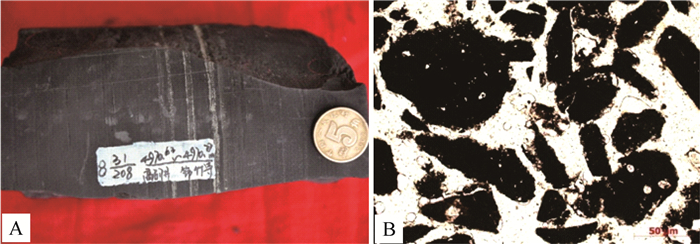
|
| 图 7 深水陆棚相区典型岩性岩芯和显微镜下照片 A.高石17井,4 970 m,筇竹寺组中上部高GR段灰黑色碳质页岩;B.高石17井,5 297 m,底部部高GR段碳质页岩,见硅质生物(岩屑照片) Figure 7 Typical lithologic cores and microscopic photos of deep water shelf facies |

|
| 图 8 双鱼石—剑阁九龙山地区灯二—灯四段陆棚边界断裂 Figure 8 The continental shelf boundary fault of the second-fouth Shuangyushi-Jiange in Jiulongshan during the second to fourth segment of the Dengying Formation |
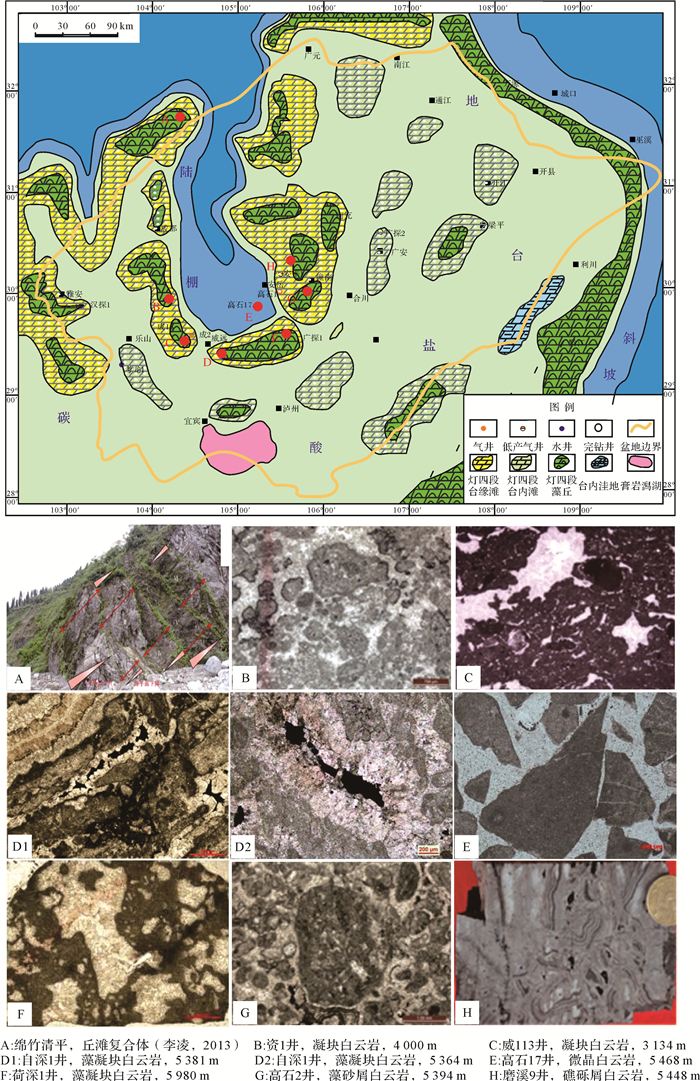
|
| 图 9 上扬子灯影组二段沉积期环广元—绵阳—磨溪陆棚的丘滩复合体 Figure 9 Bioherm reef complex on the outside of the Guangyuan-Mianyang-Moxi continental shelf during sedimentary period of the second segment of the Dengying Formation |
从构造与岩性看,E-C转换时期,广元—绵阳—磨溪深水陆棚北段向北西开口,边界断裂易于识别,东侧陡、西侧缓,灯二段—灯四段沉积过程中有所迁移(图 9);长宁—毕节深水陆棚向南开口,边界特征不明显,陆棚展布主要由下寒武统厚度增大反映。
3 E-C转换时期上扬子台—棚分异格局的地球动力学机制及演化 3.1 上扬子西缘中新元古界三叉裂谷的提出通过对四川盆地及周缘基底结构、古隆起和中新元古界裂谷发育及分布的研究,认为中新元古界(760~650 Ma左右)Rodinia大陆的裂解控制了整个上扬子E-C转换时期沉积古地理格局,期间伴随的古隆起的形成演化深刻影响了沉积物质的组成与分布。
从全球而言,Grenvillez造山运动使超大陆聚合后,延续300 Ma的时限。大致在825 Ma左右,Rodinia超大陆开始裂解。上扬子周缘一些列的火山岩浆事件记录了该地区Rodinia超大陆裂解事件(图 10)[23-28],西侧相当川西—滇中裂谷发育有苏雄组双峰式火山岩(803±12) Ma,汶川棉虒的深灰色黑云母化绿帘石化花岗岩的U-Pb锆石年龄为766 Ma茂县的文镇黄水河组灰色千枚变流纹岩获得了781~764 Ma的U-Pb锆石年龄,在碧口草溪沟灰绿色变斑状流纹岩中获得了765 Ma的火山岩年龄,在南江新民电站2 km处深灰色中粒黑云母闪长岩获得了763 Ma的年龄,在平利花坝以北2 km处的灰绿色透闪片岩获得了764 Ma的年龄。这些说明在760 Ma左右,在上扬子的西缘和北缘发生了区域性的构造岩浆事件。
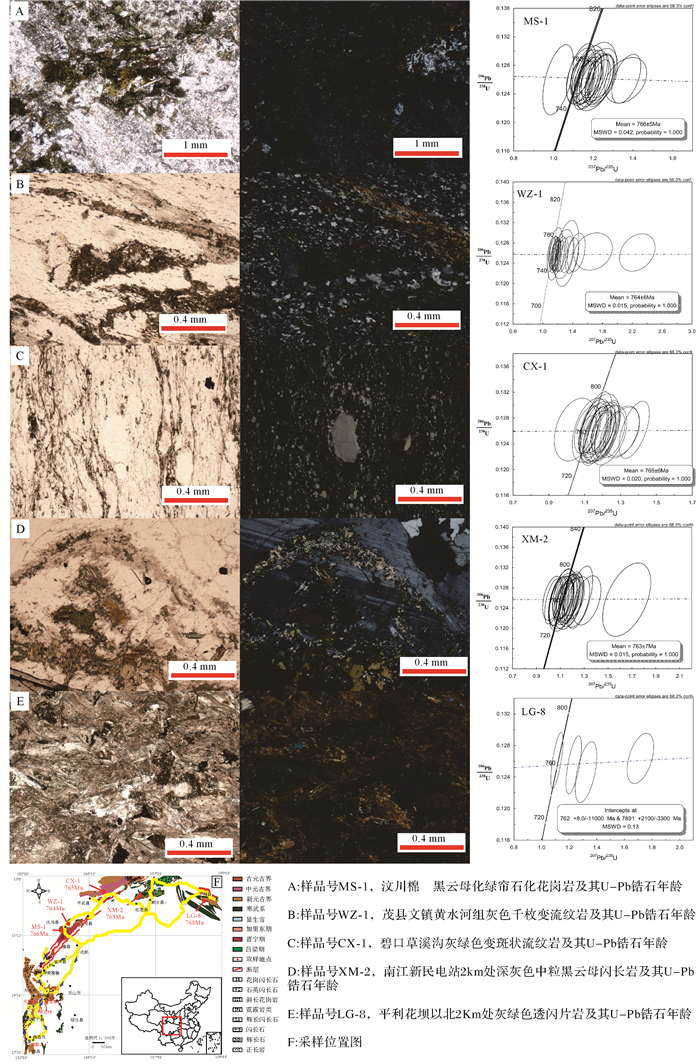
|
| 图 10 上扬子西北缘中新元古界部分火成岩U-Pb锆石年龄 Figure 10 Ages of zircons of Mesoproterozoic-Neoproterozoic igneous rocks from the northwestern margin of the upper Yangtze |
扬子西缘865~765 Ma的岩浆岩具有双峰式岩石类型特征,部分样品具有碱性岩石系列特征。稀土和微量元素(图 11)显示,扬子西缘865~765 Ma的玄武质岩浆岩具有两种类型,即OIB型和E-MORB型。各类不相容元素的分析显示,扬子西缘865~765 Ma的玄武质岩浆岩具有板内玄武岩的特征,显示其成因与陆内裂谷环境密切相关。GM01Hf样品的176Hf/177Hf在0.282 328~0.282 477之间,平均值为0.282 393,锆石Hf同位素初始比值εHf(t=0.855 Ga)均为正值,介于2.37~7.74之间(平均值为5.49);单阶段“亏损地幔”Hf模式年龄(tDM1)介于1.11~1.31 Ma,两阶段“地壳”Hf模式年龄(tDM2)介于1.26~1.58 Ma(平均年龄为1.39 Ga)表 1。XM02Hf样品的176Hf/177Hf在0.282 453~0.282 642之间,平均值为0.282 497,锆石Hf同位素初始比值εHf(t=0.763 Ga)均为正值,介于4.6~11.83之间(平均值为7.14);单阶段“亏损地幔”Hf模式年龄(tDM1)介于0.89~1.12 Ga,两阶段“地壳”Hf模式年龄(tDM2)介于0.95~1.33 Ga(平均年龄为1.22 Ga)(表 1)。CX01Hf样品的176 Hf /177Hf在0.282 153~0.282 467之间,平均值为0.282 265,锆石Hf同位素初始比值εHf(t=0.765 Ga)介于-5.69~5.17之间(平均值为-1.04);单阶段“亏损地幔”Hf模式年龄(tDM1)介于1.12~1.58 Ga之间,两阶段“地壳”Hf模式年龄(tDM2)介于1.33~2.04 Ga(平均年龄为1.74 Ga)(表 1)。MZ01Hf样品的176Hf/177Hf在0.282 460~0.282 566之间,平均值为0.282 502,锆石Hf同位素初始比值εHf(t=0.764 Ga)均为正值,介于5.09~9.07之间(平均值为7.32);单阶段“亏损地幔”Hf模式年龄(tDM1)于0.98~1.12 Ga之间,两阶段“地壳”Hf模式年龄(tDM2)介于1.11~1.33 Ga之间(平均年龄为1.20 Ga)(表 1)。这些Hf同位素特征说明有幔源岩浆参与了新生地壳的形成[29]。

|
| 图 11 上扬子西部和西北部地区基底部岩浆岩元素特征及岩性解释 a.微量元素;b.稀土元素;c.Zr/TiO2-Nb/Y图解 Figure 11 Elemental characteristics and lithologic interpretation of igneous rocks in the basement of the western and northwestern parts of the upper Yangtze |
| 测点号 | 176Lu/177Hf | 176/Hf/177Hf | 2σ | εHf(0) | εHf(t) | 2σ | tDM1/Ga | tDM2/Ga | fLu/Hf |
| GM01-01 | 0.001 436 | 0.282 372 | 0.000 012 | -14.14 | 3.94 | 0.42 | 1.26 | 1.49 | -0.96 |
| GM01-02 | 0.001 638 | 0.282 428 | 0.000 014 | -12.17 | 5.80 | 0.50 | 1.18 | 1.37 | -0.95 |
| GM01-03 | 0.001 322 | 0.282 416 | 0.000 011 | -12.58 | 5.57 | 0.40 | 1.19 | 1.39 | -0.96 |
| GM01-04 | 0.001 23 | 0.282 41 | 0.000 013 | -12.82 | 5.39 | 0.46 | 1.20 | 1.40 | -0.96 |
| GM01-05 | 0.001 262 | 0.282 405 | 0.000 011 | -12.98 | 5.21 | 0.40 | 1.20 | 1.41 | -0.96 |
| GM01-06 | 0.001 365 | 0.282 41 | 0.000 012 | -12.80 | 5.33 | 0.41 | 1.20 | 1.40 | -0.96 |
| GM01-07 | 0.001 323 | 0.282 392 | 0.000 010 | -13.45 | 4.70 | 0.37 | 1.23 | 1.44 | -0.96 |
| GM01-08 | 0.001 277 | 0.282 402 | 0.000 013 | -13.10 | 5.07 | 0.45 | 1.21 | 1.42 | -0.96 |
| GM01-09 | 0.001 392 | 0.282 428 | 0.000 011 | -12.15 | 5.96 | 0.39 | 1.18 | 1.36 | -0.96 |
| GM01-10 | 0.001 907 | 0.282 462 | 0.000 011 | -10.97 | 6.85 | 0.39 | 1.14 | 1.31 | -0.94 |
| GM01-11 | 0.001 328 | 0.282 433 | 0.000 011 | -11.98 | 6.17 | 0.39 | 1.17 | 1.35 | -0.96 |
| GM01-12 | 0.001 029 | 0.282 425 | 0.000 011 | -12.26 | 6.06 | 0.37 | 1.17 | 1.36 | -0.97 |
| GM01-13 | 0.001 896 | 0.282 477 | 0.000 011 | -10.44 | 7.39 | 0.37 | 1.12 | 1.27 | -0.94 |
| GM01-14 | 0.001 456 | 0.282 425 | 0.000 011 | -12.26 | 5.81 | 0.40 | 1.18 | 1.37 | -0.96 |
| GM01-15 | 0.001 559 | 0.282 451 | 0.000 011 | -11.34 | 6.67 | 0.40 | 1.15 | 1.32 | -0.95 |
| GM01-16 | 0.001 647 | 0.282 396 | 0.000 010 | -13.30 | 4.67 | 0.37 | 1.23 | 1.44 | -0.95 |
| GM01-17 | 0.001 578 | 0.282 399 | 0.000 010 | -13.18 | 4.82 | 0.35 | 1.22 | 1.43 | -0.95 |
| GM01-18 | 0.002 094 | 0.282 446 | 0.000 013 | -11.51 | 6.20 | 0.46 | 1.17 | 1.35 | -0.94 |
| GM01-19 | 0.001 665 | 0.282 412 | 0.000 014 | -12.73 | 5.23 | 0.49 | 1.21 | 1.41 | -0.95 |
| GM01-20 | 0.001 805 | 0.282 434 | 0.000 012 | -11.96 | 5.91 | 0.43 | 1.18 | 1.37 | -0.95 |
| GM01-21 | 0.001 572 | 0.282 431 | 0.000 012 | -12.06 | 5.95 | 0.41 | 1.18 | 1.36 | -0.95 |
| GM01-22 | 0.001 241 | 0.282 383 | 0.000 011 | -13.77 | 4.42 | 0.39 | 1.24 | 1.46 | -0.96 |
| GM01-23 | 0.001 79 | 0.282 434 | 0.000 012 | -11.96 | 5.93 | 0.41 | 1.18 | 1.36 | -0.95 |
| GM01-24 | 0.001 161 | 0.282 422 | 0.000 012 | -12.37 | 5.87 | 0.41 | 1.18 | 1.37 | -0.97 |
| GM01-25 | 0.001 29 | 0.282 328 | 0.000 010 | -15.71 | 2.45 | 0.36 | 1.31 | 1.58 | -0.96 |
| XM02-01 | 0.001 91 | 0.282 642 | 0.000 012 | -4.62 | 11.28 | 0.44 | 0.89 | 0.95 | -0.94 |
| XM02-02 | 0.001 413 | 0.282 574 | 0.000 014 | -7.00 | 9.14 | 0.50 | 0.97 | 1.09 | -0.96 |
| XM02-03 | 0.001 648 | 0.282 591 | 0.000 013 | -6.39 | 9.63 | 0.44 | 0.95 | 1.06 | -0.95 |
| XM02-04 | 0.001 226 | 0.282 563 | 0.000 012 | -7.38 | 8.85 | 0.42 | 0.98 | 1.11 | -0.96 |
| XM02-05 | 0.000 977 | 0.282 519 | 0.000 012 | -8.95 | 7.41 | 0.43 | 1.04 | 1.20 | -0.97 |
| XM02-06 | 0.001 577 | 0.282 502 | 0.000 012 | -9.55 | 6.50 | 0.42 | 1.08 | 1.26 | -0.95 |
| XM02-07 | 0.001 532 | 0.282 56 | 0.000 013 | -7.51 | 8.57 | 0.45 | 0.99 | 1.13 | -0.95 |
| XM02-08 | 0.001 078 | 0.282 492 | 0.000 014 | -9.91 | 6.40 | 0.48 | 1.08 | 1.26 | -0.97 |
| XM02-09 | 0.001 246 | 0.282 513 | 0.000 012 | -9.16 | 7.06 | 0.43 | 1.05 | 1.22 | -0.96 |
| XM02-10 | 0.001 339 | 0.282 5 | 0.000 015 | -9.64 | 6.54 | 0.54 | 1.07 | 1.26 | -0.96 |
| XM02-11 | 0.000 971 | 0.282 453 | 0.000 017 | -11.28 | 5.08 | 0.60 | 1.13 | 1.35 | -0.97 |
| XM02-12 | 0.001 396 | 0.282 511 | 0.000 013 | -9.24 | 6.91 | 0.45 | 1.06 | 1.23 | -0.96 |
| XM02-13 | 0.001 912 | 0.282 508 | 0.000 015 | -9.33 | 6.56 | 0.53 | 1.08 | 1.25 | -0.94 |
| XM02-14 | 0.001 421 | 0.282 507 | 0.000 013 | -9.38 | 6.76 | 0.47 | 1.07 | 1.24 | -0.96 |
| XM02-15 | 0.001 03 | 0.282 477 | 0.000 013 | -10.42 | 5.91 | 0.44 | 1.10 | 1.30 | -0.97 |
| XM02-16 | 0.001 211 | 0.282 536 | 0.000 013 | -8.36 | 7.88 | 0.46 | 1.02 | 1.17 | -0.96 |
| XM02-17 | 0.001 244 | 0.282 483 | 0.000 013 | -10.24 | 5.99 | 0.47 | 1.10 | 1.29 | -0.96 |
| XM02-18 | 0.001 142 | 0.282 493 | 0.000 014 | -9.86 | 6.42 | 0.48 | 1.08 | 1.26 | -0.97 |
| XM02-19 | 0.001 331 | 0.282 515 | 0.000 014 | -9.08 | 7.10 | 0.48 | 1.05 | 1.22 | -0.96 |
| XM02-20 | 0.001 159 | 0.282 461 | 0.000 013 | -11.00 | 5.27 | 0.45 | 1.12 | 1.34 | -0.97 |
| XM02-21 | 0.001 057 | 0.282 505 | 0.000 013 | -9.43 | 6.89 | 0.45 | 1.06 | 1.23 | -0.97 |
| XM02-22 | 0.001 608 | 0.282 525 | 0.000 014 | -8.74 | 7.30 | 0.49 | 1.05 | 1.21 | -0.95 |
| XM02-23 | 0.001 516 | 0.282 476 | 0.000 014 | -10.49 | 5.60 | 0.51 | 1.11 | 1.31 | -0.95 |
| XM02-24 | 0.001 955 | 0.282 548 | 0.000 014 | -7.91 | 7.96 | 0.49 | 1.02 | 1.17 | -0.94 |
| XM02-25 | 0.000 823 | 0.282 46 | 0.000 015 | -11.02 | 5.42 | 0.53 | 1.11 | 1.33 | -0.98 |
| CX01-01 | 0.001 356 | 0.282 272 | 0.000 015 | -17.69 | -1.49 | 0.52 | 1.40 | 1.76 | -0.96 |
| CX01-02 | 0.000 948 | 0.282 428 | 0.000 016 | -12.18 | 4.23 | 0.56 | 1.16 | 1.40 | -0.97 |
| CX01-03 | 0.001 311 | 0.282 294 | 0.000 020 | -16.91 | -0.69 | 0.71 | 1.36 | 1.71 | -0.96 |
| CX01-04 | 0.001 331 | 0.282 257 | 0.000 019 | -18.23 | -2.02 | 0.68 | 1.42 | 1.80 | -0.96 |
| CX01-05 | 0.000 907 | 0.282 218 | 0.000 017 | -19.61 | -3.19 | 0.60 | 1.46 | 1.87 | -0.97 |
| CX01-06 | 0.000 861 | 0.282 24 | 0.000 015 | -18.82 | -2.37 | 0.54 | 1.42 | 1.82 | -0.97 |
| CX01-07 | 0.001 583 | 0.282 467 | 0.000 016 | -10.80 | 5.29 | 0.56 | 1.13 | 1.34 | -0.95 |
| CX01-08 | 0.001 312 | 0.282 283 | 0.000 021 | -17.29 | -1.07 | 0.76 | 1.38 | 1.74 | -0.96 |
| CX01-09 | 0.001 637 | 0.282 187 | 0.000 022 | -20.69 | -4.64 | 0.79 | 1.53 | 1.96 | -0.95 |
| CX01-10 | 0.001 413 | 0.282 242 | 0.000 015 | -18.75 | -2.59 | 0.51 | 1.44 | 1.83 | -0.96 |
| CX01-11 | 0.002 286 | 0.282 247 | 0.000 020 | -18.57 | -2.85 | 0.69 | 1.47 | 1.85 | -0.93 |
| CX01-12 | 0.001 849 | 0.282 259 | 0.000 020 | -18.16 | -2.21 | 0.71 | 1.43 | 1.81 | -0.94 |
| CX01-13 | 0.001 048 | 0.282 397 | 0.000 013 | -13.27 | 3.09 | 0.45 | 1.21 | 1.48 | -0.97 |
| CX01-14 | 0.002 419 | 0.282 327 | 0.000 017 | -15.74 | -0.08 | 0.59 | 1.36 | 1.67 | -0.93 |
| CX01-15 | 0.002 485 | 0.282 323 | 0.000 016 | -15.90 | -0.27 | 0.56 | 1.37 | 1.69 | -0.93 |
| CX01-16 | 0.000 996 | 0.282 258 | 0.000 016 | -18.19 | -1.82 | 0.58 | 1.40 | 1.78 | -0.97 |
| CX01-17 | 0.000 822 | 0.282 214 | 0.000 014 | -19.74 | -3.28 | 0.48 | 1.46 | 1.88 | -0.98 |
| CX01-18 | 0.000 485 | 0.282 2 | 0.000 018 | -20.22 | -3.58 | 0.64 | 1.46 | 1.90 | -0.99 |
| CX01-19 | 0.001 458 | 0.282 244 | 0.000 022 | -18.67 | -2.53 | 0.77 | 1.44 | 1.83 | -0.96 |
| CX01-20 | 0.002 735 | 0.282 445 | 0.000 015 | -11.57 | 3.93 | 0.51 | 1.20 | 1.42 | -0.92 |
| CX01-21 | 0.001 138 | 0.282 165 | 0.000 016 | -21.47 | -5.17 | 0.56 | 1.54 | 2.00 | -0.97 |
| CX01-22 | 0.001 095 | 0.282 398 | 0.000 016 | -13.23 | 3.11 | 0.58 | 1.21 | 1.47 | -0.97 |
| CX01-23 | 0.001 637 | 0.282 324 | 0.000 018 | -15.85 | 0.20 | 0.65 | 1.33 | 1.66 | -0.95 |
| CX01-24 | 0.001 372 | 0.282 312 | 0.000 014 | -16.27 | -0.08 | 0.48 | 1.34 | 1.68 | -0.96 |
| CX01-25 | 0.001 822 | 0.282 153 | 0.000 017 | -21.88 | -5.93 | 0.61 | 1.58 | 2.04 | -0.95 |
| MZ01-01 | 0.001 498 | 0.282 515 | 0.000 015 | -9.08 | 7.04 | 0.52 | 1.06 | 1.22 | -0.95 |
| MZ01-02 | 0.001 419 | 0.282 566 | 0.000 018 | -7.29 | 8.87 | 0.65 | 0.98 | 1.11 | -0.96 |
| MZ01-03 | 0.001 359 | 0.282 522 | 0.000 014 | -8.85 | 7.34 | 0.50 | 1.04 | 1.21 | -0.96 |
| MZ01-04 | 0.001 104 | 0.282 55 | 0.000 014 | -7.84 | 8.48 | 0.48 | 1.00 | 1.13 | -0.97 |
| MZ01-05 | 0.001 276 | 0.282 546 | 0.000 012 | -7.98 | 8.25 | 0.43 | 1.01 | 1.15 | -0.96 |
| MZ01-06 | 0.001 236 | 0.282 476 | 0.000 018 | -10.46 | 5.79 | 0.63 | 1.10 | 1.30 | -0.96 |
| MZ01-07 | 0.001 06 | 0.282 46 | 0.000 016 | -11.02 | 5.31 | 0.56 | 1.12 | 1.33 | -0.97 |
| MZ01-08 | 0.001 15 | 0.282 511 | 0.000 012 | -9.22 | 7.07 | 0.42 | 1.05 | 1.22 | -0.97 |
| MZ01-09 | 0.001 694 | 0.282 541 | 0.000 014 | -8.17 | 7.85 | 0.48 | 1.02 | 1.17 | -0.95 |
| MZ01-10 | 0.001 372 | 0.282 544 | 0.000 013 | -8.06 | 8.12 | 0.44 | 1.01 | 1.16 | -0.96 |
| MZ01-11 | 0.002 011 | 0.282 557 | 0.000 013 | -7.60 | 8.26 | 0.47 | 1.01 | 1.15 | -0.94 |
| MZ01-12 | 0.001 444 | 0.282 501 | 0.000 014 | -9.58 | 6.56 | 0.50 | 1.07 | 1.25 | -0.96 |
| MZ01-13 | 0.001 156 | 0.282 537 | 0.000 015 | -8.32 | 7.98 | 0.53 | 1.02 | 1.17 | -0.97 |
| MZ01-14 | 0.001 111 | 0.282 549 | 0.000 012 | -7.90 | 8.41 | 0.42 | 1.00 | 1.14 | -0.97 |
| MZ01-15 | 0.001 154 | 0.282 503 | 0.000 013 | -9.52 | 6.77 | 0.45 | 1.06 | 1.24 | -0.97 |
| MZ01-16 | 0.000 752 | 0.282 501 | 0.000 014 | -9.58 | 6.91 | 0.49 | 1.06 | 1.23 | -0.98 |
| MZ01-17 | 0.001 318 | 0.282 534 | 0.000 012 | -8.42 | 7.79 | 0.43 | 1.02 | 1.18 | -0.96 |
| MZ01-18 | 0.001 847 | 0.282 565 | 0.000 013 | -7.32 | 8.62 | 0.45 | 0.99 | 1.12 | -0.94 |
| MZ01-19 | 0.001 036 | 0.282 534 | 0.000 013 | -8.41 | 7.95 | 0.44 | 1.02 | 1.17 | -0.97 |
| MZ01-20 | 0.001 594 | 0.282 517 | 0.000 012 | -9.01 | 7.05 | 0.42 | 1.06 | 1.22 | -0.95 |
| MZ01-21 | 0.001 754 | 0.282 505 | 0.000 016 | -9.43 | 6.56 | 0.57 | 1.08 | 1.26 | -0.95 |
| MZ01-22 | 0.000 999 | 0.282 487 | 0.000 019 | -10.09 | 6.28 | 0.66 | 1.08 | 1.27 | -0.97 |
| MZ01-23 | 0.001 092 | 0.282 498 | 0.000 015 | -9.69 | 6.63 | 0.53 | 1.07 | 1.25 | -0.97 |
| MZ01-24 | 0.000 746 | 0.282 481 | 0.000 017 | -10.28 | 6.22 | 0.60 | 1.08 | 1.28 | -0.98 |
| MZ01-25 | 0.001 026 | 0.282 507 | 0.000 017 | -9.39 | 6.97 | 0.60 | 1.05 | 1.23 | -0.97 |
据上述岩石地化特征,认为伴随Rodinia大陆的裂解,中元古晚期—新元古时期,上扬子的西部和北部边缘发育了多条裂谷,裂谷的中心或三联点的位置大致在荥经、宝兴一带,向北东方向的一支大致沿现今龙门山的后山断裂带,也就是松潘甘孜地块与扬子地块的边界裂开,裂开的深度已经达到了上地幔,龙门山西侧的甘孜—理塘洋盆可能最早出现在此时期,是Rodinia大陆裂解的产物。向北西方向,可能沿丹巴、小金—金川伸入古祁连海域。在绵阳—广元、安康—平利、乐山—内江—女基井一线,有伸进上扬子台地内部的次级裂谷发育(图 12)[23-28, 30-52]。这些裂谷在灯影及寒武纪初期的再活化控制了同时期的沉积格局和古岩溶的分布。
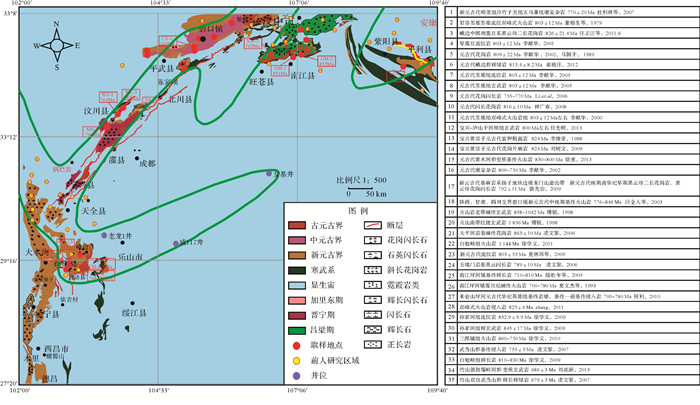
|
| 图 12 上扬子西部和西北部地区中—新元古界基底裂谷分布图 Figure 12 Distribution map of Mesoproterozoic-Neoproterozoic basal rift in the western and northwestern parts of the upper Yangtze |
绵阳—广元—磨溪裂谷演化可以分为大致六个阶段(图 13):
(1) 继承性基底断裂形成阶段:形成于760 Ma(±),Rodinia大陆裂解的产物。
(2) 首次活化阶段:首次活化发生在灯影组等三段沉积的初期,表现为局限分布的灯影组三段泥岩。随后接受灯三段晚期及灯四段的沉积,灯影组末期,受桐湾运动剥蚀的影响,资4井和高石17井均缺失灯四段。
(3) 再次活化阶段:始于麦地坪组沉积期,麦地坪组沉积局限分布在裂谷内。据资4井、峨眉山露头资料,麦地坪组岩性主要为黑色含磷硅质岩、硅质白云岩,夹有胶磷矿条带,显示此时水体变深。该套地层并不是在四川叠合盆地全都存在,如拉张槽中部的高石17井即沉积有285 m,资4井厚171 m,而高部位的高石1井则没有该套地层的沉积,黑色泥岩直接与下伏灯影组白云岩接触。
(4) 高潮阶段:发生在筇竹寺组沉积期,在裂谷的中心沉积了巨厚的黑色页岩,该地层为典型的深水陆棚沉积,这一过程一直持续到筇竹寺组沉积后期。筇竹寺组下部黑色泥/页岩其颜色为黑、褐黑至灰黑色,一般碳质含量较高且染手。黑色页岩水平层理发育。黑色泥/页岩主要脆性矿物为石英、长石、方解石和黄铁矿;而黏土矿物主要是高岭石、蒙脱石、伊利石、铝土,一般黄铁矿呈层分布。筇竹寺组中上部为灰黑色、灰黄色、灰绿色泥质粉砂岩。随着海平面的快速上升,整个扬子地台沉积筇竹寺组黑色泥岩,裂谷内为典型的深水陆棚相。随后,海平面缓慢上升到下降,岩性逐渐过渡为灰黄色灰绿色粉砂质泥岩,钙质页岩,为浅水陆棚相。
(5) 填平补齐阶段:发生在沧浪铺组沉积期,由黑色页岩向砂岩过渡,表明水体变浅,岩性主要为长石岩屑砂岩,岩相为陆棚相,但在裂谷区仍然较厚一些,如高石17井厚度214 m,而高石1井仅91 m;
(6) 碎屑岩向碳酸盐岩的转化(龙王庙组沉积期):发生在龙王庙组沉积期,岩性都已为碳酸盐岩,区域构造应力由拉长转为挤压,川西古隆起向川中推进,与川北古隆起联合,控制了随后的早古生代沉积物质分布。
4 结论与讨论灯三、灯四段沉积期和早寒武世的古地理研究显示,上扬子地区中新元古界—早寒武世,具有明显的台棚分异格局,发育有广元—绵阳—磨溪、城口、峨边、彭水老厂坪和毕节等陆棚。整体呈近南北向展布,向边缘的开阔海开口,呈喇叭状。其中,以广元—绵阳—大磨溪为最大,长约200 km,最宽处大于100 km,最窄处30 km,约5.4×104 km2,下震旦统陡山沱组—上震旦统灯影组三段—下寒武统筇竹寺组,从初始出现到最后消亡,经历了约110 Ma。台地上为碳酸盐岩沉积,深水陆棚相区内发育麦地坪+筇竹寺+沧浪铺黑色含磷硅质岩、硅质白云岩,夹有胶磷矿条带(资4井),环陆棚发育碳酸盐岩颗粒滩。导致上扬子地区E-C转换时期台—棚分异古地理格局的地球动力学因素应该是Rodinia超大陆裂解,因为沿川北和川西北广泛分布的800~760 Ma的火成岩的元素地球化学特征和Hf同位素组成指示,中元古晚期—新元古时期,上扬子的西部和北部边缘发育了多条裂谷,裂谷的中心或三联点的位置大致在荥经、宝兴一带,向北东方向的一支大致演化成陆间裂谷,沿现今龙门山的后山断裂带,也就是松潘甘孜地块与扬子地块的边界裂开,裂开的深度已经达到了上地幔,龙门山西侧的甘孜—理塘洋盆可能最早出现在此时期。向北西方向的一支应该为原洋裂谷,可能沿丹巴、小金—金川伸入古祁连海域。在绵阳—广元、安康—平利、乐山—内江—女基井一线,有伸进上扬子台地内部的次级裂谷发育。这些裂谷在新元古—早寒武世的间歇性活化,控制了E-C转换时期的台棚格局。
本文尽管从露头剖面、钻井和地震等资料精细刻画了E-C转换阶段关键时期的古地理面貌,揭示了台棚分异格局,也从区域岩浆事件记录提出了超大陆裂解所形成的裂谷的再活化为E-C转换期台棚分异格局的地球动力学因素。但是,760 Ma之后的古地理格局和灯影期—早寒武世裂谷再活化的证据尚需进一步充实。
| [1] | Wang J G, Chen D Z, Yan D T, et al. Evolution from an anoxic to oxic deep ocean during the Ediacaran-Cambrian transition and implications for bioradiation[J]. Chemical Geology, 2012, 306-307: 129–138. DOI: 10.1016/j.chemgeo.2012.03.005 |
| [2] | Guo Q J, Deng Y N, Hippler D, et al. REE and trace element patterns from organic-rich rocks of the Ediacaran-Cambrian transitional interval[J]. Gondwana Research, 2016, 36: 94–106. DOI: 10.1016/j.gr.2016.03.012 |
| [3] | Fan H F, Wen H J, Zhu X K. Marine redox conditions in the Early Cambrian Ocean:insights from the Lower Cambrian phosphorite deposits, South China[J]. Journal of Earth Science, 2016, 27(2): 282–296. DOI: 10.1007/s12583-016-0687-3 |
| [4] | Fan H F, Wen H J, Zhu X K, et al. Hydrothermal activity during Ediacaran-Cambrian transition:silicon isotopic evidence[J]. Precambrian Research, 2013, 224: 23–35. DOI: 10.1016/j.precamres.2012.09.004 |
| [5] | Li D, Ling H F, Shields-Zhou G A, et al. Carbon and strontium isotope evolution of seawater across the Ediacaran-Cambrian transition:evidence from the Xiaotan section, NE Yunnan, South China[J]. Precambrian Research, 2013, 225: 128–147. DOI: 10.1016/j.precamres.2012.01.002 |
| [6] | Chang C, Hu W X, Fu Q, et al. Characterization of trace elements and carbon isotopes across the Ediacaran-Cambrian boundary in Anhui Province, South China:implications for stratigraphy and paleoenvironment reconstruction[J]. Journal of Asian Earth Sciences, 2016, 125: 58–70. DOI: 10.1016/j.jseaes.2016.05.014 |
| [7] | Chen D Z, Zhou X Q, Fu Y, et al. New U-Pb zircon ages of the Ediacaran-Cambrian boundary strata in South China[J]. Terra Nova, 2015, 27(1): 62–68. DOI: 10.1111/ter.12134 |
| [8] | Wang J G, Chen D Z, Wang D, et al. Petrology and geochemistry of chert on the marginal zone of Yangtze Platform, western Hunan, South China, during the Ediacaran-Cambrian transition[J]. Sedimentology, 2012, 59(3): 809–829. DOI: 10.1111/sed.2012.59.issue-3 |
| [9] | Cremonese L, Shields-Zhou G A, Struck U, et al. Nitrogen and organic carbon isotope stratigraphy of the Yangtze Platform during the Ediacaran-Cambrian transition in South China[J]. Palaeogeography, Palaeoclimatology, Palaeoecology, 2014, 398: 165–186. DOI: 10.1016/j.palaeo.2013.12.016 |
| [10] | Gao P, Liu G D, Jia C Z, et al. Redox variations and organic matter accumulation on the Yangtze carbonate platform during late Ediacaran-early Cambrian:constraints from petrology and geochemistry[J]. Palaeogeography, Palaeoclimatology, Palaeoecology, 2016, 450: 91–110. DOI: 10.1016/j.palaeo.2016.02.058 |
| [11] | Guo Q J, Strauss H, Zhu M Y, et al. High resolution organic carbon isotope stratigraphy from a slope to basinal setting on the Yangtze Platform, South China:implications for the Ediacaran-Cambrian transition[J]. Precambrian Research, 2013, 225: 209–217. DOI: 10.1016/j.precamres.2011.10.003 |
| [12] | Li Y F, Fan T L, Zhang J C, et al. Geochemical changes in the Early Cambrian interval of the Yangtze Platform, South China:implications for hydrothermal influences and paleocean redox conditions[J]. Journal of Asian Earth Sciences, 2015, 109: 100–123. DOI: 10.1016/j.jseaes.2015.05.003 |
| [13] | Yang X L, Zhu M Y, Guo Q J, et al. Organic carbon isotopic evolution during the Ediacaran-Cambrian transition interval in eastern Guizhou, South China:paleoenvironmental and stratigraphic implications[J]. Acta Geologica Sinica (English Edition), 2007, 81(2): 194–203. DOI: 10.1111/acgs.2007.81.issue-2 |
| [14] | Och L M, Cremonese L, Shields-Zhou G A, et al. Palaeoceanographic controls on spatial redox distribution over the Yangtze Platform during the Ediacaran-Cambrian transition[J]. Sedimentology, 2016, 63(2): 378–410. DOI: 10.1111/sed.2016.63.issue-2 |
| [15] | Zhang Z F, Zhang Z L, Li G X, et al. The Cambrian brachiopod fauna from the first-trilobite age Shuijingtuo Formation in the Three Gorges area of China[J]. Palaeoworld, 2016, 25(3): 333–355. DOI: 10.1016/j.palwor.2015.10.001 |
| [16] | Ling H F, Chen X, Li D, et al. Cerium anomaly variations in Ediacaran-Earliest Cambrian carbonates from the Yangtze Gorges area, South China:implications for oxygenation of coeval shallow seawater[J]. Precambrian Research, 2013, 225: 110–127. DOI: 10.1016/j.precamres.2011.10.011 |
| [17] | 陈洪德, 郭彤楼, 侯明才, 等. 中上扬子叠合盆地沉积充填过程与物质分布规律[M]. 北京: 科学出版社, 2012: 19-25. [ Chen Hongde, Guo Tonglou, Hou Mingcai, et al. Depositional filling and rule of distribution in middle-upper Yangtze cratonic basin[M]. Beijing: Science Press, 2012: 19-25. ] |
| [18] | 邢凤存, 侯明才, 林良彪, 等. 四川盆地晚震旦世-早寒武世构造运动记录及动力学成因讨论[J]. 地学前缘, 2015, 22 (1): 115–125. [ Xing Fengcun, Hou Mingcai, Lin Liangbiao, et al. The records and its dynamic genesis discussion of tectonic movement during the late Sinian and the early Cambrian of Sichuan Basin[J]. Earth Science Frontiers, 2015, 22(1): 115–125. ] |
| [19] | 刘宝珺, 许效松. 中国南方岩相古地理图集[M]. 北京: 科学出版社, 1994. [ Liu Baojun, Xu Xiaosong. Atlas of lithofacies and palcogcography in south of China[M]. Beijing: Science Press, 1994. ] |
| [20] | 马永生, 陈洪德, 王国力. 中国南方构造-层序岩相古地理图集(震旦纪-新近纪)[M]. 北京: 科学出版社, 2009: 14-29. [ Ma Yongsheng, Chen Hongde, Wang Guoli, et al. Atlas of construction-sequence and lithofacies Palaeageography in South China[M]. Beijing: Science Press, 2009: 14-29. ] |
| [21] | 刘树根, 王一刚, 孙玮, 等. 拉张槽对四川盆地海相油气分布的控制作用[J]. 成都理工大学学报(自然科学版), 2016, 43 (1): 1–23. [ Liu Shugen, Wang Yigang, Sun Wei, et al. Control of intracratonic sags on the hydrocarbon accumulations in the marine strata across the Sichuan Basin, China[J]. Journal of Chengdu University of Technology(Science & Technology Edition), 2016, 43(1): 1–23. ] |
| [22] | 刘树根, 孙玮, 罗志立, 等. 兴凯地裂运动与四川盆地下组合油气勘探[J]. 成都理工大学学报(自然科学版), 2013, 40 (5): 511–520. [ Liu Shugen, Sun Wei, Luo Zhili, et al. Xingkai taphrogenesis and petroleum exploration from upper Sinian to Cambrian Strata in Sichuan Basin, China[J]. Journal of Chengdu University of Technology(Science & Technology Edition), 2013, 40(5): 511–520. ] |
| [23] | 董榕生, 李建林. 川西甘洛苏雄早震旦世地层及其火山岩系特征[J]. 成都地质学院学报, 1979 (2): 1–19, 104. [ Dong Rongsheng, Li Jianlin. Characteristics of early Sinian stratigraphic and its volcanic rocks in the Suxiong, Ganluo, western Sichuan[J]. Journal of Chengdu University of Technology, 1979(2): 1–19, 104. ] |
| [24] | 闫全人, 王宗起, HansonA D, 等. 扬子板块西北缘碧口群火山岩系的SHRIMP年代、Sr-Nd-Pb同位素特征及意义[J]. 地质学报, 2003, 77 (4): 590. [ Yan Quanren, Wang Zongqi, Hanson A D, et al. SHRIMP chronology and Sr-Nd-Pb isotope characteristics of volcanic rocks in the northwestern of the Yangtze Plate and its geological implication[J]. Acta Geologica Sinica, 2003, 77(4): 590. ] |
| [25] | 任光明, 庞维华, 孙志明, 等. 扬子西缘黄水河群玄武岩锆石SHRIMP U-Pb定年及其地质意义[J]. 中国地质, 2013, 40 (4): 1007–1015. [ Ren Guangming, Pang Weihua, Sun Zhiming, et al. Zircon SHRIMP U-Pb dating of basalt from Huangshuihe Group on the western margin of the Yangtze Block and its geological significance[J]. Geology in China, 2013, 40(4): 1007–1015. ] |
| [26] | 杜利林, 耿元生, 杨崇辉, 等. 扬子地台西缘康定群的再认识:来自地球化学和年代学证据[J]. 地质学报, 2007, 81 (11): 1562–1577. [ Du Lilin, Geng Yuansheng, Yang Chonghui, et al. New understanding on Kangding Group on western margin of Yangtze Block:evidence from geochemistry and chronology[J]. Acta Geologica Sinica, 2007, 81(11): 1562–1577. DOI: 10.3321/j.issn:0001-5717.2007.11.011 ] |
| [27] | 汪正江, 王剑, 杨平, 等. 上扬子克拉通内新元古代A型花岗岩的发现及其地质意义[J]. 沉积与特提斯地质, 2011, 31 (2): 1–11. [ Wang Zhengjiang, Wang Jian, Yang Ping, et al. The discovery and geological implications of the Neoproterozoic A-type granites in the upper Yangtze Craton[J]. Sedimentary Geology and Tethyan Geology, 2011, 31(2): 1–11. ] |
| [28] | 李献华, 周汉文, 李正祥, 等. 扬子块体西缘新元古代双峰式火山岩的锆石U-Pb年龄和岩石化学特征[J]. 地球化学, 2001, 30 (4): 315–322. [ Li Xianhua, Zhou Hanwen, Li Zhengxiang, et al. Zircon U-Pb age and petrochemical characteristics of the Neoproterozoic bimodal volcanics from western Yangtze Block[J]. Geochemica, 2001, 30(4): 315–322. ] |
| [29] | 吴福元, 葛文春, 孙德有, 等. 中国东部岩石圈减薄研究中的几个问题[J]. 地学前缘, 2003, 10 (3): 51–60. [ Wu Fuyuan, Ge Wenchun, Sun Deyou, et al. Discussions on the lithospheric thinning in eastern China[J]. Earth Science Frontiers, 2003, 10(3): 51–60. ] |
| [30] | 李献华, 李正祥, 周汉文, 等. 川西新元古代玄武质岩浆岩的锆石U-Pb年代学、元素和Nd同位素研究:岩石成因与地球动力学意义[J]. 地学前缘, 2002, 9 (4): 329–338. [ Li Xianhua, Li Zhengxiang, Zhou Hanwen, et al. U-Pb zircon geochronological, geochemical and Nd isotopic study of neoproterozoic basaltic magmatism in western Sichuan:petrogenesis and geodynamic implications[J]. Earth Science Frontiers, 2002, 9(4): 329–338. ] |
| [31] | 马国干, 张自超, 李华芹, 等. 扬子地台震旦系同位素年代地层学的研究[C]//中国地质科学院宜昌地质矿产研究所文集(14). 北京: 中国地质学会, 1989. [ Ma Guogan, Zhang Zichao, Li Huaqin, et al. A geochronostratigraphical study of the Sinian system in Yangtze platform[C]//Collected by Yichang Institute of Geology and Mineral Resources, Chinese Academy of Geological Sciences. Beijing:Geological Society of China, 1989. ] http://cpfd.cnki.com.cn/Article/CPFDTOTAL-ZGDJ198908001005.htm |
| [32] | 崔晓庄, 江新胜, 王剑, 等. 川西峨边地区金口河辉绿岩脉SHRIMP锆石U-Pb年龄及其对Rodinia裂解的启示[J]. 地质通报, 2012, 31 (7): 1131–1141. [ Cui Xiaozhuang, Jiang Xinsheng, Wang Jian, et al. Zircon SHRIMP U-Pb age of Jinkouhe diabase dykes in Ebian area of western Sichuan province and its implications for the breakup of Rodinia[J]. Geological Bulletin of China, 2012, 31(7): 1131–1141. ] |
| [33] | 李献华, 祁昌实, 刘颖, 等. 扬子块体西缘新元古代双峰式火山岩成因:Hf同位素和Fe/Mn新制约[J]. 科学通报, 2005, 50 (19): 2155–2160. [ Li Xianhua, Qi Changshi, Liu Ying, et al. Petrogenesis of the Neoproterozoic bimodal volcanic rocks along the western margin of the Yangtze Block:New constraints from Hf isotopes and Fe/Mn ratios[J]. Chinese Science Bulletin, 2005, 50(19): 2155–2160. DOI: 10.3321/j.issn:0023-074X.2005.19.015 ] |
| [34] | Li W X, Li X H, Li Z X. Neoproterozoic bimodal magmatism in the Cathaysia Block of South China and its tectonic significance[J]. Precambrain Research, 2005, 136(1): 51–66. DOI: 10.1016/j.precamres.2004.09.008 |
| [35] | 林广春. 扬子西缘瓦斯沟花岗岩的元素-Nd同位素地球化学:岩石成因与构造意义[J]. 岩石矿物学杂志, 2008, 27 (5): 398–404. [ Lin Guangchun. Petrochemical characteristics of Wasigou complex in western Yangtze Block:petrogenetic and tectonic significance[J]. Acta Petrologica et Mineralogica, 2008, 27(5): 398–404. ] |
| [36] | 李献华, 周汉文, 李正祥, 等. 扬子块体西缘新元古代双峰式火山岩的锆石U-Pb年龄和地球化学特征[C]//中国古陆块构造演化与超大陆旋回专题学术会议论文摘要集. 北京: 中国地质学会, 2000. [ Li Xianhua, Zhou Hanwen, Li Zhengxiang, et al. Zircon U-Pb age and geochemical characteristics of the Neoproterozoic bimodal volcanics from western Yangtze Block[C]//Proceedings of the Symposium on Tectonic Evolution and Supercontinent Cycles of China Craton. Beijing:Geological Society of China, 2000. ] http://cpfd.cnki.com.cn/Article/CPFDTOTAL-ZGDJ200012001015.htm |
| [37] | 李维亚. 四川宝兴县黄店子地区富钾粗面岩类的岩石特征[J]. 现代地质, 1988, 2 (4): 451–465, 531. [ Li Weiya. The petrographic characters of potasium-rich trachyte of Huangdianzi Group in Baoxing county, Sichuan province[J]. Geoscience, 1988, 2(4): 451–465, 531. ] |
| [38] | 刘树文, 杨恺, 李秋根, 等. 新元古代宝兴杂岩的岩石成因及其对扬子西缘构造环境的制约[J]. 地学前缘, 2009, 16 (2): 107–118. [ Liu Shuwen, Yang Kai, Li Qiugen, et al. Petrogenesis of the Neoproterozoic Baoxing complex and its constraint on the tectonic environment in western margin of Yangtze Craton[J]. Earth Science Frontiers, 2009, 16(2): 107–118. ] |
| [39] | 徐速. 龙门山中段基性一超基性岩类地质特征及成因探讨[D]. 成都: 成都理工大学, 2013. [ Xu Su. Geological characteristics and genesis of basic-ultrabasic rocks in the middle of the Longmen Mountain[D]. Chengdu:Chengdu University of Technology, 2013. ] http://cdmd.cnki.com.cn/Article/CDMD-10616-1013287555.htm |
| [40] | 裴先治, 丁仨平, 李佐臣, 等. 龙门山造山带轿子顶新元古代花岗岩锆石SHRIMP U-Pb年龄及其构造意义[J]. 西北大学学报(自然科学版), 2009, 39 (3): 425–433. [ Pei Xianzhi, Ding Sanping, Li Zuochen, et al. Zircon SHRIMP U-Pb age of the neoproterozoic Jiaoziding granite in the Longmenshan Orogenic Belt and their tectonic significance[J]. Journal of Northwest University(Natural Science Edition), 2009, 39(3): 425–433. ] |
| [41] | 傅锐, 向虹. 陕西勉略宁元古宙海相火山岩成岩构造环境及演化[J]. 有色金属矿产与勘查, 1998, 7 (6): 346–355. [ Fu Rui, Xiang Hong. The diagenetic structural environment and structural evolution of Proterozoic marine volcanic rocks in the Miaxian-Lueyang-Ningqiang Area, Shaanxi[J]. Geological Exploration for Non-Ferrous Metals, 1998, 7(6): 346–355. ] |
| [42] | 凌文黎, 高山, 程建萍, 等. 扬子陆核与陆缘新元古代岩浆事件对比及其构造意义:来自黄陵和汉南侵入杂岩ELA-ICPMS锆石U-Pb同位素年代学的约束[J]. 岩石学报, 2006, 22 (2): 387–396. [ Ling Wenli, Gao Shan, Cheng Jianping, et al. Neoproterozoic magmatic events within the Yangtze continental interior and along its northern margin and their tectonic implication:constraint from the ELA-ICPMS U-Pb geochronology of zircons from the Huangling and Hannan complexes[J]. Acta Petrologica Sinica, 2006, 22(2): 387–396. ] |
| [43] | 徐学义, 李婷, 陈隽璐, 等. 扬子地台北缘檬子地区侵入岩年代格架和岩石成因研究[J]. 岩石学报, 2011, 27 (3): 699–720. [ Xu Xueyi, Li Ting, Chen Junlu, et al. Zircon U-Pb age and petrogenesis of intrusions from Mengzi area in the northern margin of Yangtze Plate[J]. Acta Petrologica Sinica, 2011, 27(3): 699–720. ] |
| [44] | 夏林圻, 夏祖春, 马中平, 等. 南秦岭中段西乡群火山岩岩石成因[J]. 西北地质, 2009, 42 (2): 1–37. [ Xia Linqi, Xia Zuchun, Ma Zhongping, et al. Petrogenesis of volcanic rocks from Xixiang Group in middle part of South Qinling Mountains[J]. Northwestern Geology, 2009, 42(2): 1–37. ] |
| [45] | 陆松年, 陈志宏, 李怀坤, 等. 秦岭造山带中两条新元古代岩浆岩带[J]. 地质学报, 2005, 79 (2): 165–173. [ Lu Songnian, Chen Zhihong, Li Huaikun, et al. Two magmatic belts of the neoproterozoic in the Qinling Orogenic Belt[J]. Acta Geologica Sinica, 2005, 79(2): 165–173. ] |
| [46] | 夏文杰, 伊海生, 杜森官. 中国南方震旦纪火山岩特征及喷发构造背景[J]. 成都地质学院学报, 1993, 20 (3): 1–9. [ Xia Wenjie, Yi Haisheng, Du Senguan. The characteristics and eruptive tectonic setting of Sinian volcanic rocks in South China[J]. Journal of Chengdu College of Geology, 1993, 20(3): 1–9. ] |
| [47] | 何利. 川北坪河碱性杂岩体特征及其构造背景[D]. 成都: 成都理工大学, 2010. [ He Li. Characteristics and structural setting of the Pinghe alkalic complex in northern Sichuan[D]. Chengdu:Chengdu University of Technology, 2010. ] http://cdmd.cnki.com.cn/article/cdmd-10616-2010218201.htm |
| [48] | 徐学义, 夏林圻, 陈隽璐, 等. 扬子地块北缘西乡群孙家河组火山岩形成时代及元素地球化学研究[J]. 岩石学报, 2009, 25 (12): 3309–3326. [ Xu Xueyi, Xia Linqi, Chen Junlu, et al. Zircon U-Pb dating and geochemical study of volcanic rocks from Sunjiahe Formation of Xixiang Group in northern margin of Yangtze Plate[J]. Acta Petrologica Sinica, 2009, 25(12): 3309–3326. ] |
| [49] | 徐学义, 陈隽璐, 李向民, 等. 西乡群三郎铺组和大石沟组火山岩U-Pb定年及岩石成因研究[J]. 岩石学报, 2010, 26 (2): 617–632. [ Xu Xueyi, Chen Junlu, Li Xiangmin, et al. Geochemistry and petrogenesis of volcanic rocks from Sanlangpu Formation and Dashigou Formation[J]. Acta Petrologica Sinica, 2010, 26(2): 617–632. ] |
| [50] | 徐学义, 陈隽璐, 李向民, 等. 扬子地台北缘白勉峡组和三湾组火山岩形成构造环境及岩石成因的地球化学约束[J]. 地质学报, 2009, 83 (11): 1703–1718. [ Xu Xueyi, Chen Junlu, Li Xiangmin, et al. Geochemical constrains on the petrogenesis and tectonic setting discrimination of volcanic rocks from the Baimianxia and the Sanwan Formations[J]. Acta Geologica Sinica, 2009, 83(11): 1703–1718. DOI: 10.3321/j.issn:0001-5717.2009.11.013 ] |
| [51] | 刘成新, 胡正祥, 毛新武, 等. 南秦岭竹山地区洋岛型玄武岩的发现及构造意义[J]. 资源环境与工程, 2013, 27 (2): 109–118. [ Liu Chengxin, Hu Zhengxiang, Mao Xinwu, et al. The discovery of Oceanic Island Basalts in the Zhushan area, southern Qinling Orogenic Belt and its tectonic significance[J]. Resources Environment & Engineering, 2013, 27(2): 109–118. ] |
| [52] | 凌文黎, 任邦方, 段瑞春, 等. 南秦岭武当山群、耀岭河群及基性侵入岩群锆石U-Pb同位素年代学及其地质意义[J]. 科学通报, 2008, 53 (14): 2192–2199. [ Ling Wenli, Ren Bangfang, Duan Ruichun, et al. Timing of the Wudangshan, Yaolinghe volcanic sequences and mafic sills in South Qinling:U-Pb zircon geochronology and tectonic implications[J]. Chinese Science Bulletin, 2008, 53(14): 2192–2199. ] |
 2017, Vol. 35
2017, Vol. 35



